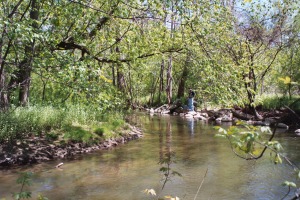 In the early 1970s, I directed a series of National Science Foundation Summer Institutes for high school and middle school teachers on Environmental Science at the University of Michigan-Dearborn. During the course, we took canoe trips on the Rouge River beginning at the Henry Ford Estate. On the trip upstream from the dam, we traveled over and around several log jams, under the Ford Road bridge and up the Middle Branch until it was too shallow for canoes. As we disembarked somewhere along Hines Drive well before Outer Drive, some people were walking on the shoulder of Hines Drive and stopped dead in their tracks to see 25 people step up the bank of the river with canoe paddles in hand. They stared in disbelief and became even more awestruck when one of the teachers told them that we were headed to Northville and could they tell us how far it was!
In the early 1970s, I directed a series of National Science Foundation Summer Institutes for high school and middle school teachers on Environmental Science at the University of Michigan-Dearborn. During the course, we took canoe trips on the Rouge River beginning at the Henry Ford Estate. On the trip upstream from the dam, we traveled over and around several log jams, under the Ford Road bridge and up the Middle Branch until it was too shallow for canoes. As we disembarked somewhere along Hines Drive well before Outer Drive, some people were walking on the shoulder of Hines Drive and stopped dead in their tracks to see 25 people step up the bank of the river with canoe paddles in hand. They stared in disbelief and became even more awestruck when one of the teachers told them that we were headed to Northville and could they tell us how far it was!
On another study session by canoe with a group of teachers, we canoed downstream from the dam when the work on the channelization was beginning. The teachers were amazed that we could canoe on the Rouge River without special permission since some highly placed official surely ruled the River with great authority. We used this teachable moment to explain access laws on waterways and riparian rights. Survey work on the channelization was just getting underway. One of the survey team members standing on the river bank challenged our presence on “his” river in a loud voice. A teacher in our program had been in the military and had the quick presence to mind to tell him that we had permission to travel on the river based on an Army code for which he made up a group of mumbo jumbo letters and numbers. He said it with such authority that the surveyor was taken aback and had nothing more to say.
In 1973, a new faculty member in our physics department was adventurous enough to suggest that we take a canoe trip on the Rouge. He grew up in New York City and wanted to explore a “wilderness area.” We borrowed a canoe from a one of our stalwart student leaders of our Natural Areas program for a journey upstream from the Estate. It was a delightful trip and my colleague wrote a piece about it for the local paper. At the same time, the Rouge was in flood stage and the water was high over the dam. One of us wondered if the water was deep enough for us to canoe over the dam. Being experimental scientists, we knew how to find the answer to that question — try it.
Sure enough, we tightened up our life jackets (now personal floatation devices) and powered on to the waterfall. The water was deep enough to carry us over the limestone pieces at the top of the dam, although bottom of the canoe scraped as it tilted forward and began its downward slide on the slanted face of the dam. For a fraction of a second we were very pleased with our successful answer to the question of our investigation – yes, we could canoe over the dam. Then the canoe got to the bottom of the waterfall and the unintended consequences syndrome took over. The bow of the canoe did not rise and float on the top of the wave like a whitewater raft would do. Instead it plowed into the wave and drenched the physics professor in the bow. When the stern of the canoe got to the bottom of the waterfall, the canoe leveled off and the water formed a tidal wave inside the canoe that headed to the stern and completely soaked the student who was sitting in the middle. Fortunately, I was in the stern because of the appropriate weight distribution for proper canoe travel. By the time the water got to me I was up on the gunwales and thwarts trying to stay dry, but only with partial success.
Then there is a part of the canoe-over-the dam story that I will not tell. But if I did, I would ask you “How many samples are experimental scientists expected to take?” Of course, they must take more than one sample or they can change one of the variables, such as rearrange the weight by putting the heavier bow person in the middle and the lighter middle person in the bow. (I still had the stern position.) Well, it takes no imagination for even the most amateur scientist to determine the results of the second run over the waterfall. We all felt that as a scientific experiment the results were inconsequential, but the “wilderness” adventure was “wildly” successful.
